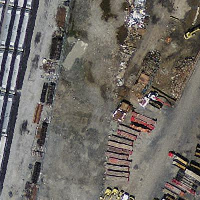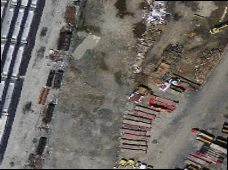Name
ST_Transform — Reprojeta um raster em um sistema de referência espacial conhecido para outro usando um algorítimo resampling especificado. As opções são NearestNeighbor, Bilinear, Cubic, CubicSpline, Lanczos com o padrão sendo NearestNeighbor.
Synopsis
raster ST_Transform(raster rast, integer srid, text algorithm=NearestNeighbor, double precision maxerr=0.125, double precision scalex, double precision scaley);
raster ST_Transform(raster rast, integer srid, double precision scalex, double precision scaley, text algorithm=NearestNeighbor, double precision maxerr=0.125);
raster ST_Transform(raster rast, raster alignto, text algorithm=NearestNeighbor, double precision maxerr=0.125);
Descrição
Reprojeta um raster em um sistema de referência espacial conhecido para outro usando um algorítimo pixel warping especificado. Usa "NearestNeighbor" se nenhum algorítimo for especificado e a porcentagem maxerror de 0.125 se nenhum maxerr for especificado.
As opções de algorítimo são: 'NearestNeighbor', 'Bilinear', 'Cubic', 'CubicSpline', e 'Lanczos'. Recorra a: GDAL Warp resampling methods para mais detalhes.
Geralmente, aST_Transform confundida com a ST_SetSRID(). Na verdade, a ST_Transform modifica as coordenadas de um raster (e resample os valores do pixel) de um sistema de referência espacial para outro, enquanto a ST_SetSRID() só altera o identificador de SRID do raster.
Diferente das outras variantes, a 3 requer um raster referência como alignto. O raster transformado será alterado para o sistema de referência espacial (SRID) do raster referência e será alinhado (ST_SameAlignment = VERDADE) ao raster referência.
![[Note]](../images/note.png)
|
|
|
If you find your transformation support is not working right, you may need to set the environment variable PROJSO to the .so or .dll projection library your PostGIS is using. This just needs to have the name of the file. So for example on windows, you would in Control Panel -> System -> Environment Variables add a system variable called |
![[Warning]](../images/warning.png)
|
|
|
When transforming a coverage of tiles, you almost always want to use a reference raster to insure same alignment and no gaps in your tiles as demonstrated in example: Variant 3. |
Disponibilidade: 2.0.0 Requer GDAL 1.6.1+
Melhorias: 2.1.0 Adição da variante ST_Transform(rast, alignto)
Exemplos
SELECT ST_Width(mass_stm) As w_before, ST_Width(wgs_84) As w_after,
ST_Height(mass_stm) As h_before, ST_Height(wgs_84) As h_after
FROM
( SELECT rast As mass_stm, ST_Transform(rast,4326) As wgs_84
, ST_Transform(rast,4326, 'Bilinear') AS wgs_84_bilin
FROM aerials.o_2_boston
WHERE ST_Intersects(rast,
ST_Transform(ST_MakeEnvelope(-71.128, 42.2392,-71.1277, 42.2397, 4326),26986) )
LIMIT 1) As foo;
w_before | w_after | h_before | h_after
----------+---------+----------+---------
200 | 228 | 200 | 170
 original mass state plane meters (mass_stm) |
 Depois transforma para wgs 84 long lat (wgs_84) |
 Depois transforma para wgs 84 long lat algorítimo bilinear em vez do padrão NN (wgs_84_bilin) |
Exemplos: Variante 3
A seguir está a diferença entre usar ST_Transform(raster, srid) e ST_Transform(raster, alignto)
WITH foo AS (
SELECT 0 AS rid, ST_AddBand(ST_MakeEmptyRaster(2, 2, -500000, 600000, 100, -100, 0, 0, 2163), 1, '16BUI', 1, 0) AS rast UNION ALL
SELECT 1, ST_AddBand(ST_MakeEmptyRaster(2, 2, -499800, 600000, 100, -100, 0, 0, 2163), 1, '16BUI', 2, 0) AS rast UNION ALL
SELECT 2, ST_AddBand(ST_MakeEmptyRaster(2, 2, -499600, 600000, 100, -100, 0, 0, 2163), 1, '16BUI', 3, 0) AS rast UNION ALL
SELECT 3, ST_AddBand(ST_MakeEmptyRaster(2, 2, -500000, 599800, 100, -100, 0, 0, 2163), 1, '16BUI', 10, 0) AS rast UNION ALL
SELECT 4, ST_AddBand(ST_MakeEmptyRaster(2, 2, -499800, 599800, 100, -100, 0, 0, 2163), 1, '16BUI', 20, 0) AS rast UNION ALL
SELECT 5, ST_AddBand(ST_MakeEmptyRaster(2, 2, -499600, 599800, 100, -100, 0, 0, 2163), 1, '16BUI', 30, 0) AS rast UNION ALL
SELECT 6, ST_AddBand(ST_MakeEmptyRaster(2, 2, -500000, 599600, 100, -100, 0, 0, 2163), 1, '16BUI', 100, 0) AS rast UNION ALL
SELECT 7, ST_AddBand(ST_MakeEmptyRaster(2, 2, -499800, 599600, 100, -100, 0, 0, 2163), 1, '16BUI', 200, 0) AS rast UNION ALL
SELECT 8, ST_AddBand(ST_MakeEmptyRaster(2, 2, -499600, 599600, 100, -100, 0, 0, 2163), 1, '16BUI', 300, 0) AS rast
), bar AS (
SELECT
ST_Transform(rast, 4269) AS alignto
FROM foo
LIMIT 1
), baz AS (
SELECT
rid,
rast,
ST_Transform(rast, 4269) AS not_aligned,
ST_Transform(rast, alignto) AS aligned
FROM foo
CROSS JOIN bar
)
SELECT
ST_SameAlignment(rast) AS rast,
ST_SameAlignment(not_aligned) AS not_aligned,
ST_SameAlignment(aligned) AS aligned
FROM baz
rast | not_aligned | aligned
------+-------------+---------
t | f | t

not_aligned
|

aligned
|